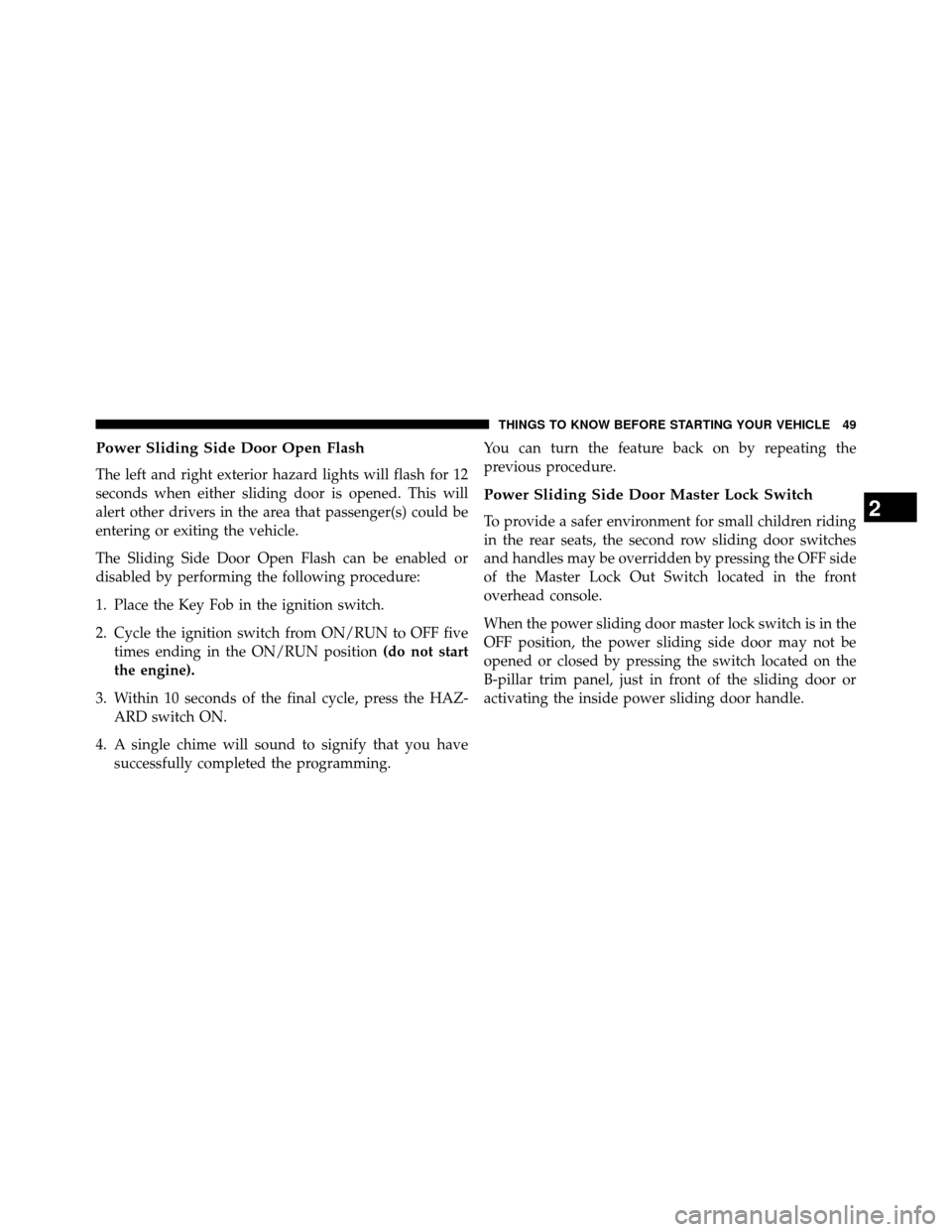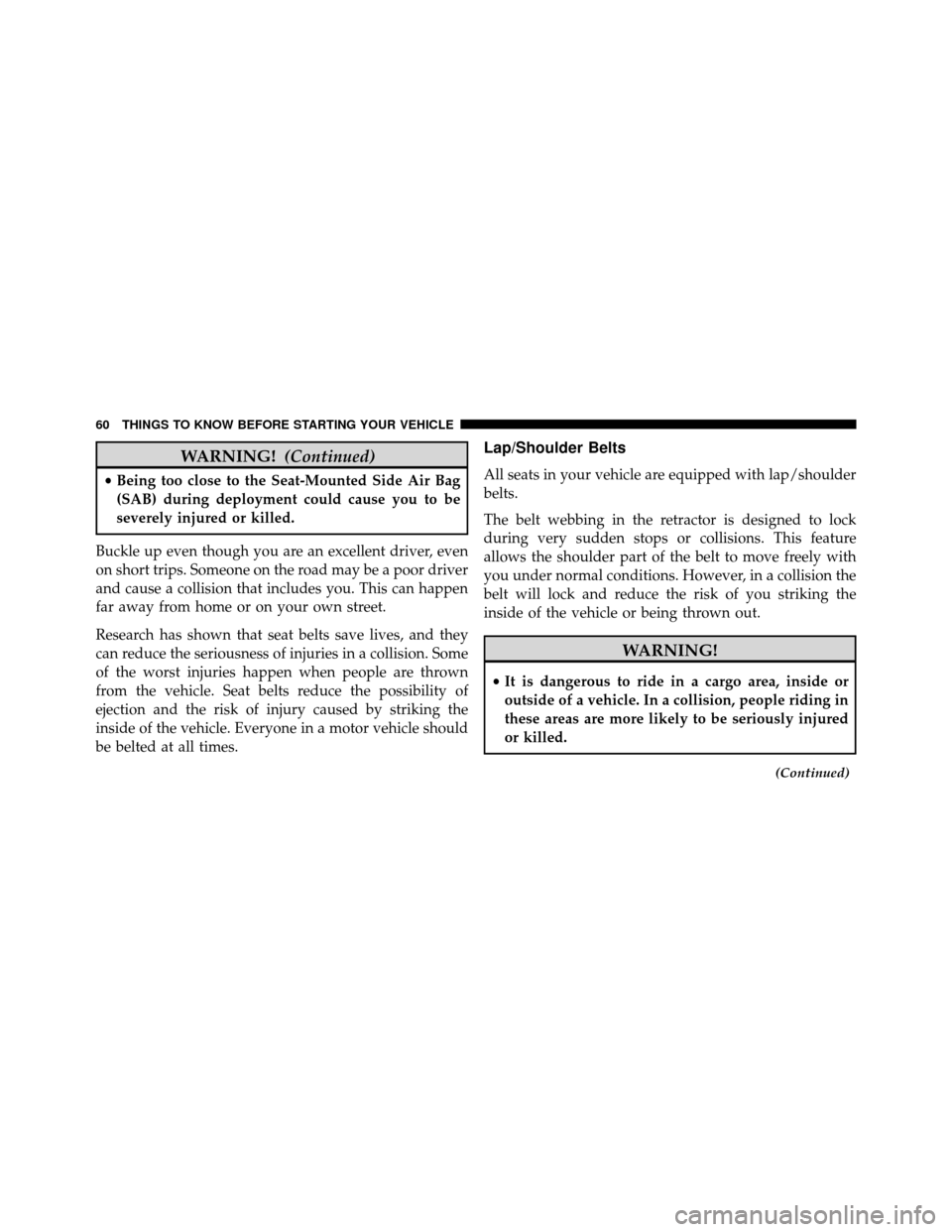Page 42 of 698
WINDOWS
Power Vent Windows — If Equipped
The Power Vent Window Switch located on the driver’s
door trim panel allows the driver to operate the two vent
windows from the driver’s seat.
Power Windows
You can control either the front or rear windows using
switches located on the driver’s door trim panel. The
switches will operate only when the ignition switch is in
the ON/RUN or ACC position and during power acces-
sory delay.
Power Vent Window Switch Open/CloseDriver ’s Power Window Switches
40 THINGS TO KNOW BEFORE STARTING YOUR VEHICLE
Page 49 of 698

NOTE:Pulling the outside power sliding door handle a
second time while the sliding door is power opening or
power closing will allow the sliding door to be opened or
closed manually.
Press the button on the RKE transmitter twice within five
seconds to open a power sliding door. When the door is
fully open, pressing the button twice within five seconds
a second time will close the door.
There are power sliding side door switches located on the
B-pillar trim panel, just in front of the power sliding door
for the rear seat passengers and in the overhead console
for the driver and passengers. Pressing the switch once
will open the power sliding door. If the switch is pressed
while the door is under a power cycle, the door will
reverse direction.
NOTE: The power sliding side door must be unlocked
before the power sliding door switches will operate. If the inside or outside door handles are used while the
power sliding side door is activated, the power sliding
door feature will be canceled and will go into manual
mode.
Power Sliding Door Switch
2
THINGS TO KNOW BEFORE STARTING YOUR VEHICLE 47
Page 51 of 698

Power Sliding Side Door Open Flash
The left and right exterior hazard lights will flash for 12
seconds when either sliding door is opened. This will
alert other drivers in the area that passenger(s) could be
entering or exiting the vehicle.
The Sliding Side Door Open Flash can be enabled or
disabled by performing the following procedure:
1. Place the Key Fob in the ignition switch.
2. Cycle the ignition switch from ON/RUN to OFF fivetimes ending in the ON/RUN position (do not start
the engine).
3. Within 10 seconds of the final cycle, press the HAZ- ARD switch ON.
4. A single chime will sound to signify that you have successfully completed the programming. You can turn the feature back on by repeating the
previous procedure.
Power Sliding Side Door Master Lock Switch
To provide a safer environment for small children riding
in the rear seats, the second row sliding door switches
and handles may be overridden by pressing the OFF side
of the Master Lock Out Switch located in the front
overhead console.
When the power sliding door master lock switch is in the
OFF position, the power sliding side door may not be
opened or closed by pressing the switch located on the
B-pillar trim panel, just in front of the sliding door or
activating the inside power sliding door handle.2
THINGS TO KNOW BEFORE STARTING YOUR VEHICLE 49
Page 53 of 698
3. Repeat Steps 1 and 2 on the opposite sliding door.NOTE:
•
After engaging the Child Protection Door Lock, always
test the door from the inside to make certain it is in the
desired position.
• When the Child Protection Door Lock system is en-
gaged, (even if the inside door lock is in the unlocked
position) the door can be opened only by using the
outside door handle, the RKE transmitter, the switches
on the overhead console or the switches located on the
trim panel just in front of the power sliding door.
• The power sliding side door will operate from the
switches located on the B-pillar trim panel, just in front
of the power sliding door, regardless of the Child
Protection Door Lock lever position. To avoid unin-
tentional operation of the power sliding door from
the rear seats, press the “OFF” Master Lock Out
Switch located in the front overhead console, next to
the driver.
Child Protection Door Lock
2
THINGS TO KNOW BEFORE STARTING YOUR VEHICLE 51
Page 59 of 698

OCCUPANT RESTRAINTS
Some of the most important safety features in your
vehicle are the restraint systems:
•Three-point lap and shoulder belts for all seating
positions
•
Advanced Front Air Bags for driver and front passenger
• Supplemental Active Head Restraints (AHR) located
on top of the front seats (integrated into the head
restraint)
• Supplemental Driver Side Knee Air Bag
• Supplemental Seat-Mounted Side Air Bags (SAB)
• An energy-absorbing steering column and steering
wheel
• Knee bolsters/blockers for front seat occupants •
Front seat belts incorporate pretensioners that may
enhance occupant protection by managing occupant
energy during an impact event
• The front passenger seat includes an Automatic Lock-
ing Retractor (ALR) which locks the seat belt webbing
into position by extending the belt all the way out and
then adjusting the belt to the desired length to restrain
a child seat or secure a large item in a seat
Please pay close attention to the information in this
section. It tells you how to use your restraint system
properly, to keep you and your passengers as safe as
possible.
2
THINGS TO KNOW BEFORE STARTING YOUR VEHICLE 57
Page 60 of 698

NOTE:The Advanced Front Air Bags have a multistage
inflator design. This allows the air bag to have different
rates of inflation based on several factors, including the
severity and type of collision.
Here are some simple steps you can take to minimize the
risk of harm from a deploying air bag:
1. Children 12 years old and under should always ride
buckled up in a rear seat.
WARNING!
• Never place a rear facing infant seat in front of an
air bag. A deploying Passenger Advanced Front Air
Bag can cause death or serious injury to a child 12
years or younger, including a child in a rearward
facing infant seat.
• Only use a rearward-facing child restraint in a
vehicle with a rear seat. Children that are not big enough to wear the vehicle seat
belt properly (see section on Child Restraints) should be
secured in child restraints or belt-positioning booster
seats. Older children who do not use child restraints or
belt-positioning booster seats should ride properly buck-
led up in the passenger seat. Never allow children to
slide the shoulder belt behind them or under their arm.
If a child from 2 to 12 years old (not in a rear facing child
seat) must ride in the front passenger seat, move the seat
as far back as possible and use the proper child restraint.
(Refer to “Child Restraints”).
You should read the instructions provided with your
child restraint to make sure that you are using it properly.
2.
All occupants should always wear their lap and
shoulder belts properly.
3. The driver and front passenger seats should be
moved back as far as practical to allow the Advanced
Front Air Bags room to inflate.
58 THINGS TO KNOW BEFORE STARTING YOUR VEHICLE
Page 62 of 698

WARNING!(Continued)
•Being too close to the Seat-Mounted Side Air Bag
(SAB) during deployment could cause you to be
severely injured or killed.
Buckle up even though you are an excellent driver, even
on short trips. Someone on the road may be a poor driver
and cause a collision that includes you. This can happen
far away from home or on your own street.
Research has shown that seat belts save lives, and they
can reduce the seriousness of injuries in a collision. Some
of the worst injuries happen when people are thrown
from the vehicle. Seat belts reduce the possibility of
ejection and the risk of injury caused by striking the
inside of the vehicle. Everyone in a motor vehicle should
be belted at all times.
Lap/Shoulder Belts
All seats in your vehicle are equipped with lap/shoulder
belts.
The belt webbing in the retractor is designed to lock
during very sudden stops or collisions. This feature
allows the shoulder part of the belt to move freely with
you under normal conditions. However, in a collision the
belt will lock and reduce the risk of you striking the
inside of the vehicle or being thrown out.
WARNING!
• It is dangerous to ride in a cargo area, inside or
outside of a vehicle. In a collision, people riding in
these areas are more likely to be seriously injured
or killed.
(Continued)
60 THINGS TO KNOW BEFORE STARTING YOUR VEHICLE
Page 69 of 698
Second Row Bench Seat
Driver Center Passenger
First Row N/A N/A ALR
Second Row Bench
Seating ALR ALR N/A
Third Row ALR Cinch ALR
Second Row Quad Seating
Driver Center Passenger
First Row N/A N/A ALR
Second Row Quad
Seating ALR N/A ALR
Third Row ALR Cinch ALR
Second Row Captains Chairs
Driver Center Passenger
First Row N/A N/A ALR
Second Row SnG Seating ALR N/A ALR
Third Row ALR Cinch ALR
• N/A — Not Applicable
• ALR — Automatic Locking Retractor
If the passenger seating position is equipped with an
ALR and is being used for normal usage:
Only pull the belt webbing out far enough to comfortably
wrap around the occupant’s mid-section so as to not
activate the ALR. If the ALR is activated, you will hear a
ratcheting sound as the belt retracts. Allow the webbing
to retract completely in this case and then carefully pull
2
THINGS TO KNOW BEFORE STARTING YOUR VEHICLE 67